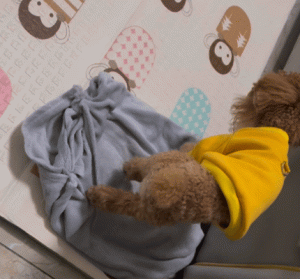A puppy’s ability to tolerate pain is very strong. Even when it feels uncomfortable, it won’t cry or scream. Instead, it can only rely on subtle actions to signal that something is wrong.But theproblem is—many dog owners mistake these behaviors as signs of being “clingy,” “affectionate,” or just “playful.” As a result, they keep delaying medical attention, which not only worsens theproblem but can even lead to serious consequences.Here are 7 abnormal dog behaviors that may look harmless on the surface but are actually cries for help.Has your dog shown any of these signs?
-
Constantly licking paws without stopping
Many people think that when a dog licks its paws, it’s just “self-cleaning.” But that’s not true—dogs don’t actually understand what being “clean” means. If your dog repeatedly licks one spot until the fur between the toes is wet, red, or even balding, something is definitely wrong. It could be pododermatitis, fungal infection, or allergies. In severe cases, it may even cause open wounds. Don’t assume that just because your dog doesn’t cry out, it’s fine—their pain tolerance is about ten times stronger than humans.
-
Suddenly shaking ears, more and more frequently
An occasional ear shake is normal, but if it becomes frequent, it’s time to be cautious. Something may have gotten inside your dog’s ears. Ear mites, fungus, or bacteria can all cause ear inflammation and infection. When you see your dog shaking its head vigorously, it’s simply trying to “shake off the discomfort.” By the time you notice redness, pus, or a foul odor in the ear canal, the problem has already become very serious.
-
Suddenly chasing its tail in endless circles
When a dog chases its tail repeatedly, some owners think it’s just “playing” or being “silly.” But behind this behavior could be parasites, anal gland blockage, or even psychological stress leading to obsessive-compulsive disorder. In severe cases, dogs may bite their own tails until they bleed, spinning in circles nonstop.

-
Rolling onto its back but breathing rapidly with a blank stare
Many dogs expose their bellies, sometimes as an invitation for belly rubs. But if you notice your dog doing this while panting heavily, trembling, or staring blankly, don’t assume it’s just asking for affection. This could actually indicate a serious heart problem. Rolling over in this state means it’s losing strength. If you miss the golden rescue window, you may not even have time to get your dog to the vet.
-
Scooting its butt on the floor
This action might look funny, but experienced dog owners know the truth: if your dog scoots frequently, and the area around the anus looks red or swollen, it may need deworming or its anal glands are blocked. Don’t dismiss this as a minor issue. Repeated anal gland blockages and infections can turn into chronic problems that might even require surgery.
-
Pressing its head against the wall and staying still
If your dog suddenly stands with its head pressed against the wall, it may look like it’s daydreaming. But don’t be fooled—this is not “thinking about life.” It often signals a neurological problem, such as increased brain pressure or nerve disorders. What looks like staring into space is actually your dog suffering from severe headaches. If this happens often, it’s a serious warning sign.
-
Hiding in a corner and ignoring you no matter what
A dog that usually tears up the house suddenly hiding under the sofa or table, refusing to come out even when called, is not “being moody” or “angry at you.” It’s likely in so much pain that it doesn’t want to move. This could be due to an injury or even a heart condition. When in pain, a dog’s instinct is to hide so others won’t see its weakness. What you need to do is not just call it out, but take it for a veterinary check-up immediately.
Dogs cannot speak. All of their pain is hidden in those small, easily overlooked behaviors. Can you read the signs? Don’t always assume your dog is just being “clingy” or “acting spoiled”sometimes, it’s truly suffering.Keep this checklist in mind, so that when your dog is at its most vulnerable, you can spot the problem right away and take action immediately. Raising a dog is not only aboutplaying with it, but also about shielding it from the pain it cannot express in words.





